The source is from the rhizome of the perennial herb, Zingibor officinale Rosc, family Zingiberaceae. The medicinal material is mainly produced in the areas of Sichuan, Guangdong, and Guangxi, etc., collected in winter, cut into pieces, dried in the sun or in low temperature, and the crude form is used.
Medicinal Properties:
Pungent in flavor, hot in nature and attributive to the spleen, stomach, heart and lung meridians.
Actions:
Warm the middle-energizer to expel cold, restore yang and dredge channels, warm the lung to resolve phlegm.

Application
1. It is used to treat spleen-cold and stomach-cold syndromes whether they are asthenia or sthenia. For stomach-cold with vomiting and cold and painful epigastric abdomen, peptic ulcer, it is usually used in combination with Gaoliangjiang ( Rhizoma Alpiniae Officinarum ), such as Er Jiang Wan (Pill); for deficiency and coldness of the spleen and stomach, usually combined with Dangshen (Radix Codonopsis ), Baizhu ( Rhizoma Atractylodis Macrocephalae), etc., such as Lizhong Wan (Pill).

2. For syndrome of yang exhaustion, it is usually combined with Fuzi (Radix Aconiti Lateralis Praeparata) for maximal effect to decrease the toxicity of Fuzi (Radix Aconiti Lateralis Praeparata ) as well as to strengthen the action of Fuzi (Radix Aconiti Lateralis Praeparata) in recuperating the depleted yang and rescuing the patient from collapse, such as Sini Tang (Decoction).
3. For cold accumulation in the lung manifested as cough and dyspnea, body's coldness and profuse thin sputum, colitis, it is usually combined with Xixin (Herba Asai ), Wuweizi ( Fructus Schisandrae ) and Mahuang ( Herba Ephedrae), such as Xiao Qinglong Tang (Decoction).
Usage and Dosage:
3 - 10 is used in decoction for oral use.







